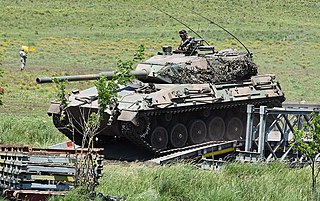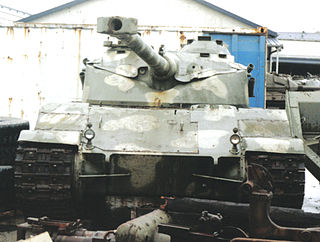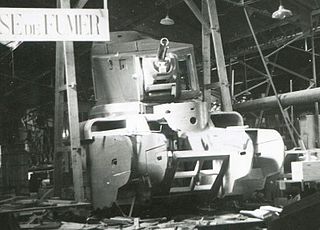Related Research Articles

The Renault FT was a French light tank that was among the most revolutionary and influential tank designs in history. The FT was the first production tank to have its armament within a fully rotating turret. The Renault FT's configuration became and remains the standard tank layout. Consequently, some armoured warfare historians have called the Renault FT the world's first modern tank.

The AMX-30 is a main battle tank designed by Ateliers de construction d'Issy-les-Moulineaux and first delivered to the French Army in August 1966. The first five tanks were issued to the 501st Régiment de Chars de Combat in August of that year. The production version of the AMX-30B weighed 36 metric tons, and sacrificed protection for increased mobility. The French believed that it would have required too much armour to protect against the latest anti-tank threats, thereby reducing the tank's maneuverability. Protection, instead, was provided by the speed and the compact dimensions of the vehicle, including a height of 2.28 metres. It had a 105 mm gun, firing a then advanced high-explosive anti-tank (HEAT) warhead known as the Obus G. The Obus G used an outer shell, separated from the main charge by ball bearings, to allow the round to be spin stabilized by the gun without spinning the warhead inside which would disrupt jet formation. Mobility was provided by the 720 horsepower (540 kW) HS-110 diesel engine, although the troublesome transmission adversely affected the tank's performance.

The Tanque Argentino Mediano is a Main Battle Tank in service with the Argentine Army. Lacking the experience and resources to design a tank, the Argentine Ministry of Defense contracted German company Thyssen-Henschel. The vehicle was developed by a German and Argentine team of engineers, and was based on the German Marder infantry fighting vehicle chassis.

The Char B1 was a French heavy tank manufactured before World War II.

Tanks were initially deployed in World War I, engineered to overcome the deadlock of trench warfare. Between the two world wars, tanks were further developed. Although they had demonstrated their battlefield effectiveness, only a few nations had the industrial resources to design and build them. During and after World War I, Britain and France pioneered tank technology, with their models generally serving as a blueprint for other countries. However, this initial advantage would slowly diminish during the 1930s, shifting in favor of the Soviet Union and, to a lesser degree, Nazi Germany.

The FCM F1 was a French super-heavy tank developed during the late Interbellum by the Forges et Chantiers de la Méditerranée (FCM) company. Twelve were ordered in 1940 to replace the Char 2C, but France was defeated before construction could begin, a wooden mock-up being all that was finished. The FCM F1 was large and elongated, and had two turrets: one in front and one in the back, with a single high-velocity gun in each turret. The rear turret was superfiring, meaning it was raised higher and fired over the top of the forward one, a common practice in naval vessels. The vehicle was intended to be heavily armoured. Its size and protection level made it by 1940, at about 140 tons, the heaviest tank ever to have actually been ordered for production. Despite two engines its speed would have been low. The primary purpose of the tank was to breach German fortification lines, not to fight enemy tanks. The development path of the FCM F1 was extremely complex, due to the existence of a number of parallel super-heavy tank projects with overlapping design goals, the specifications of which were regularly changed. For each project in turn several companies submitted one or more competing proposals.

The ARL 44 was a French heavy tank, the development of which started just before the end of the Second World War. Only sixty of these tanks were ever completed, from 1949 onwards. The type proved to be unsatisfactory and only entered limited service. The tank was phased out in 1953.

The Char D1 was an Interwar French light tank.
The Char G1 was a French replacement project for the Char D2 medium tank. Several prototypes from different companies were developed from 1936 onwards, but not a single one had been fully completed at the time of the Fall of France in 1940. The projects represented some of the most advanced French tank design of the period and finally envisaged a type that would have been roughly equal in armament and mobility to later World War II standard tanks of other nations, such as the Soviet T-34 and the American M4 Sherman, but possessing several novel features, such as gun stabilisation, a semi-automatic loader and an optical rangefinder.

A super-heavy tank or super heavy tank is any tank that is notably beyond the standard of the class heavy tank in either size or weight relative to contemporary vehicles.

The AMX-40 was a French main battle tank developed by GIAT during the latter stages of the Cold War as an export tank to replace the earlier AMX-32. Designed to be an inexpensive tank orientated towards militaries with smaller defence budgets, the AMX-40 featured a lightly armoured hull and good mobility reminiscent of previous French MBTs with a powerful 120 mm cannon. It however failed to attract interest and sales, rendering the project a failure, being discontinued in 1990.

The AMX 50 or AMX-50 is a French heavy tank designed in the immediate post Second World War period. It was proposed as, in succession, the French medium, heavy, and main battle tank, incorporating many advanced features. It was cancelled in the late 1950s however, due to unfavourable economic and political circumstances after serious delays in development.

The Light Tank, T1 was a United States Army light tank of the late 1920s and early 1930s that was only built in prototype form. The tank was an Army design built by James Cunningham, Son and Company. Introduced in 1927, it was developed up through 1932 as a series of modified versions. The tank was never mass-produced, nor was it ever used in combat.

The ELC project was a prototype light tank project launched by the French Ministry of Defense in 1955. The purpose of the ELC project was to develop a lightly armoured, heavily armed fighting vehicle capable of being airlifted for rapid deployment.

The Batignolles-Chatillon Char 25T was an early Cold War medium tank of France, developed in the 1954 by the Batignolles-Chatillon company. The vehicle was not developed beyond the two prototypes.

The "ARL Tracteur C", or ARL Char C, was a French super-heavy tank design developed during the late Interbellum by the Atelier de Construction de Rueil (ARL) company. A full-scale wooden mock-up was part produced, but the project was terminated in favor of FCM F1, a directly competing design, which proved to be superior. The vehicle was meant to be extremely heavy and for that time period, very heavily armored. ARL C was intended to be very long to meet the requirement to cross trenches up to 7 meters wide. The tank was multi-turreted like FCM F1; however, unlike FCM F1, ARL C had the main turret in front of the very long hull right behind the secondary turret, not in the back of vehicle. The development path of the ARL C was extremely complex, due to the existence of a number of parallel super-heavy tank projects with overlapping design goals, the specifications of which were regularly changed. For each project in turn several companies submitted one or more competing proposals.
The AMX Chasseur de Chars, abbreviated as the "AMX CDC", was a tank destroyer concept, designed in 1946.
The AMX 40 was a proposed French cruiser tank. It was intended to replace the SOMUA S35 and S40 tanks. The tank never went beyond design stage after the Fall of France.
The Panhard AM 40 P, also known as Model 201, was a prototype French armoured car.
The AMX Tracteur C was a super-heavy tank designed by Ateliers de construction d'Issy-les-Moulineaux(AMX).
References
- 1 2 3 Valantin, Jean-Pierre. "1937 AMX 38". Chars français (in French). Chars français sur le net. Retrieved 2 April 2015.